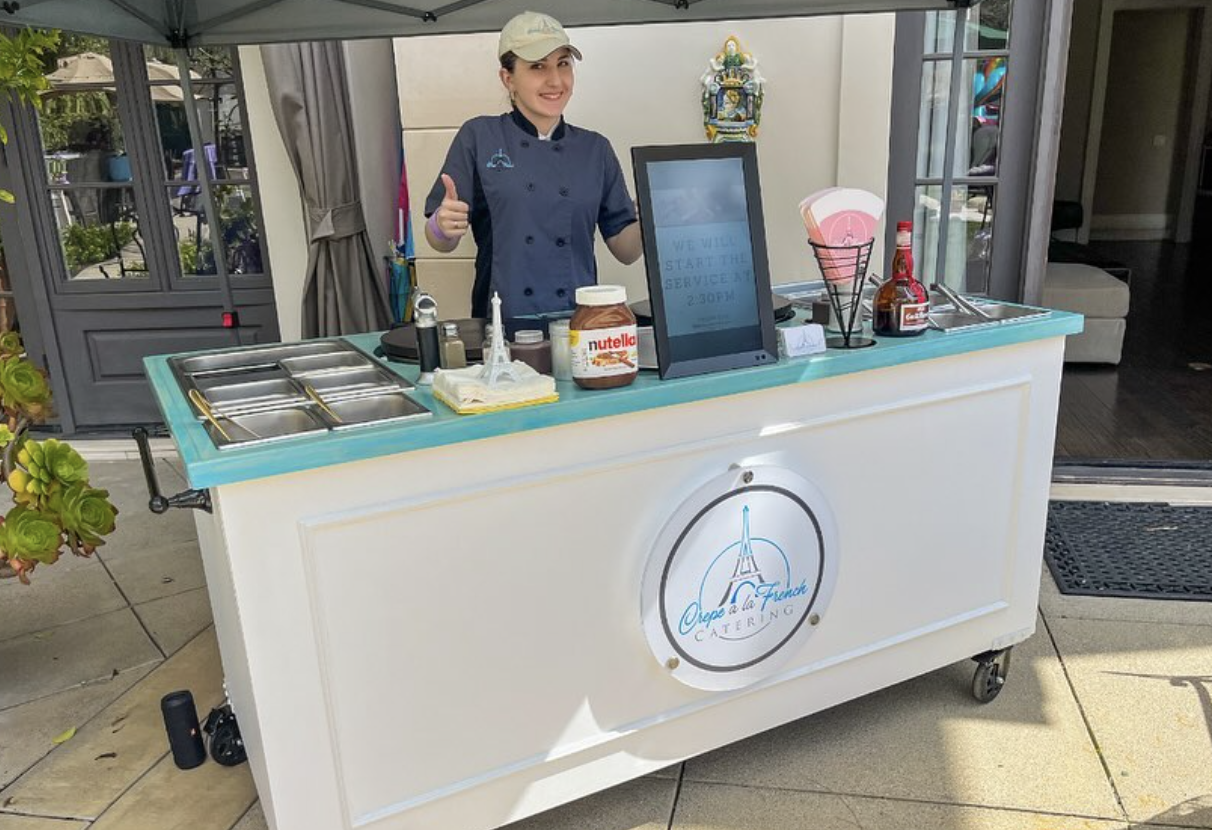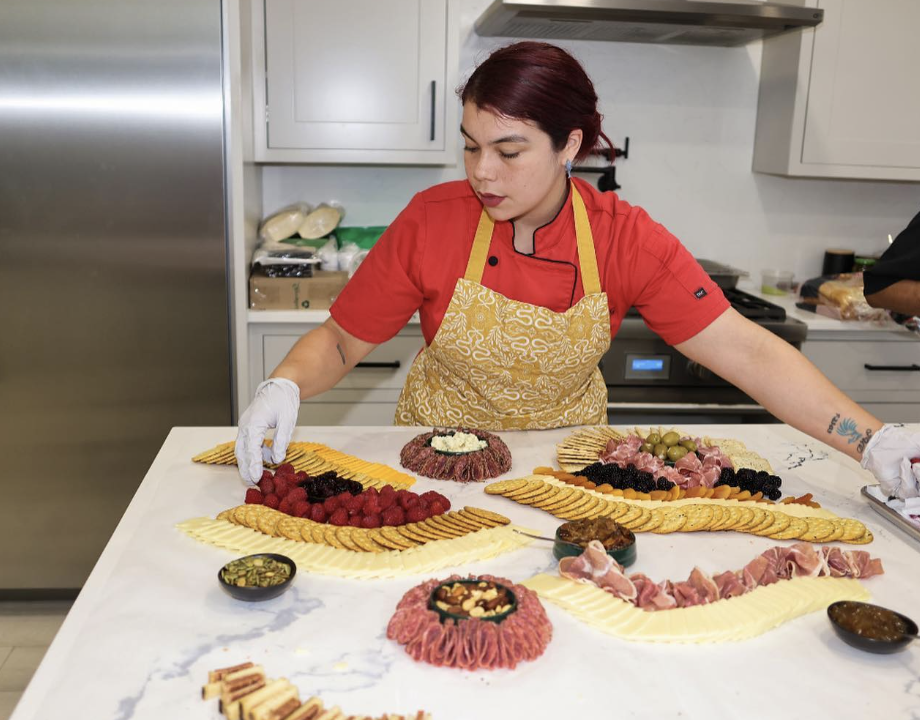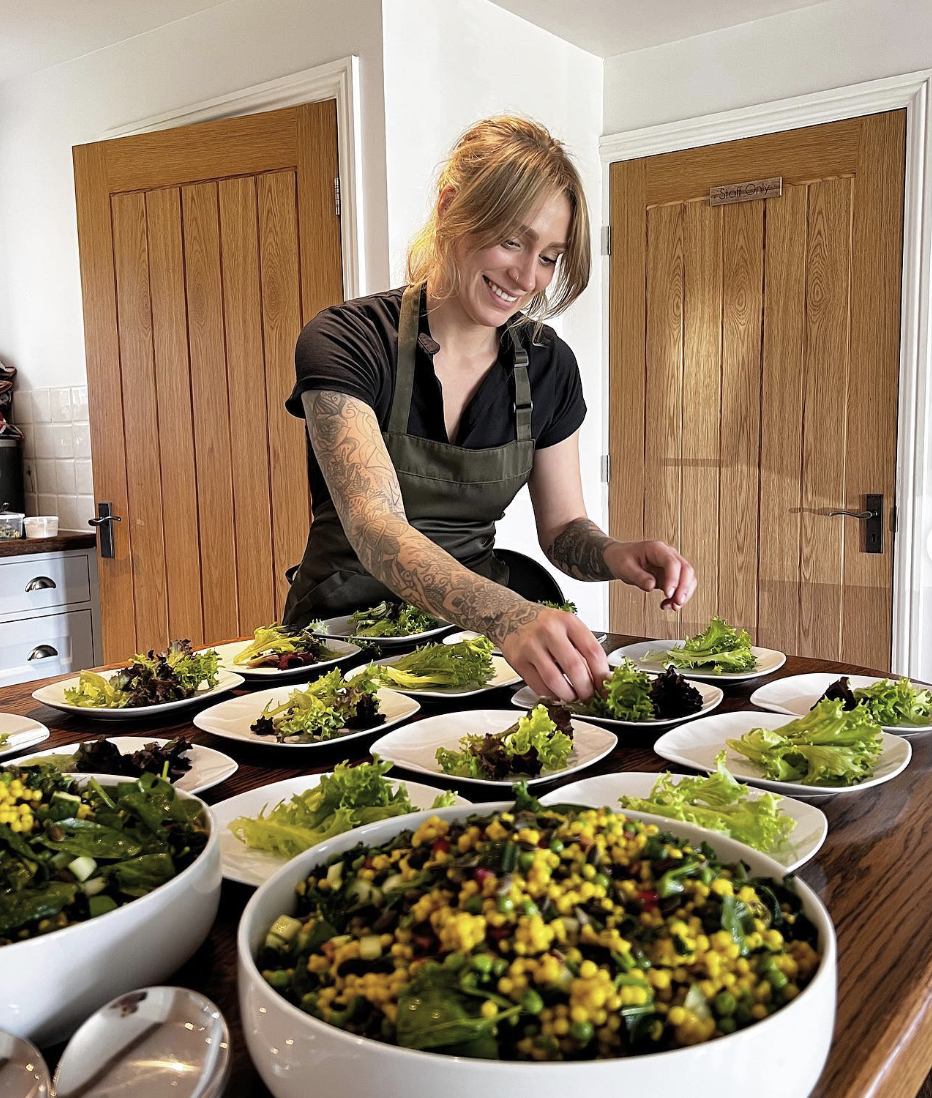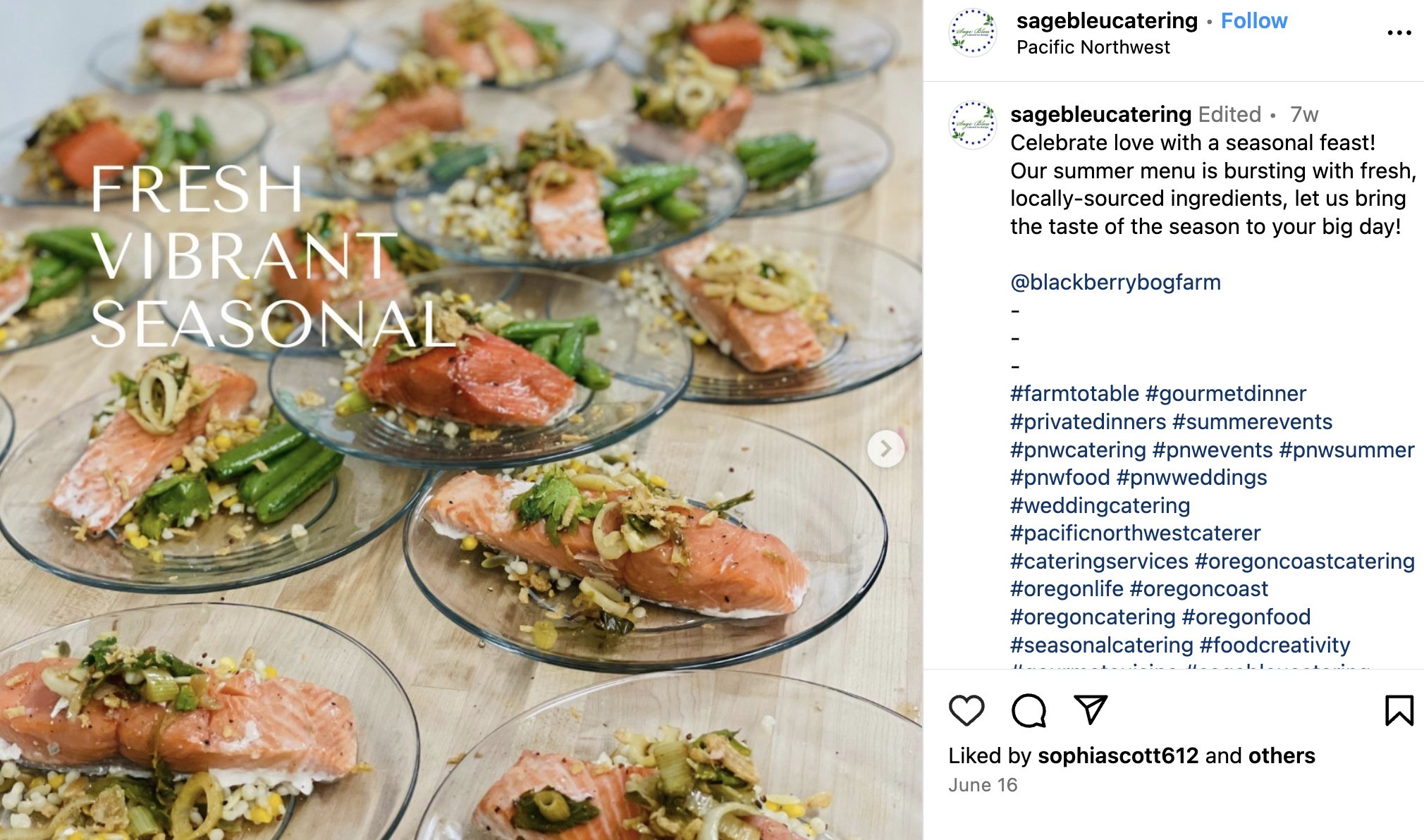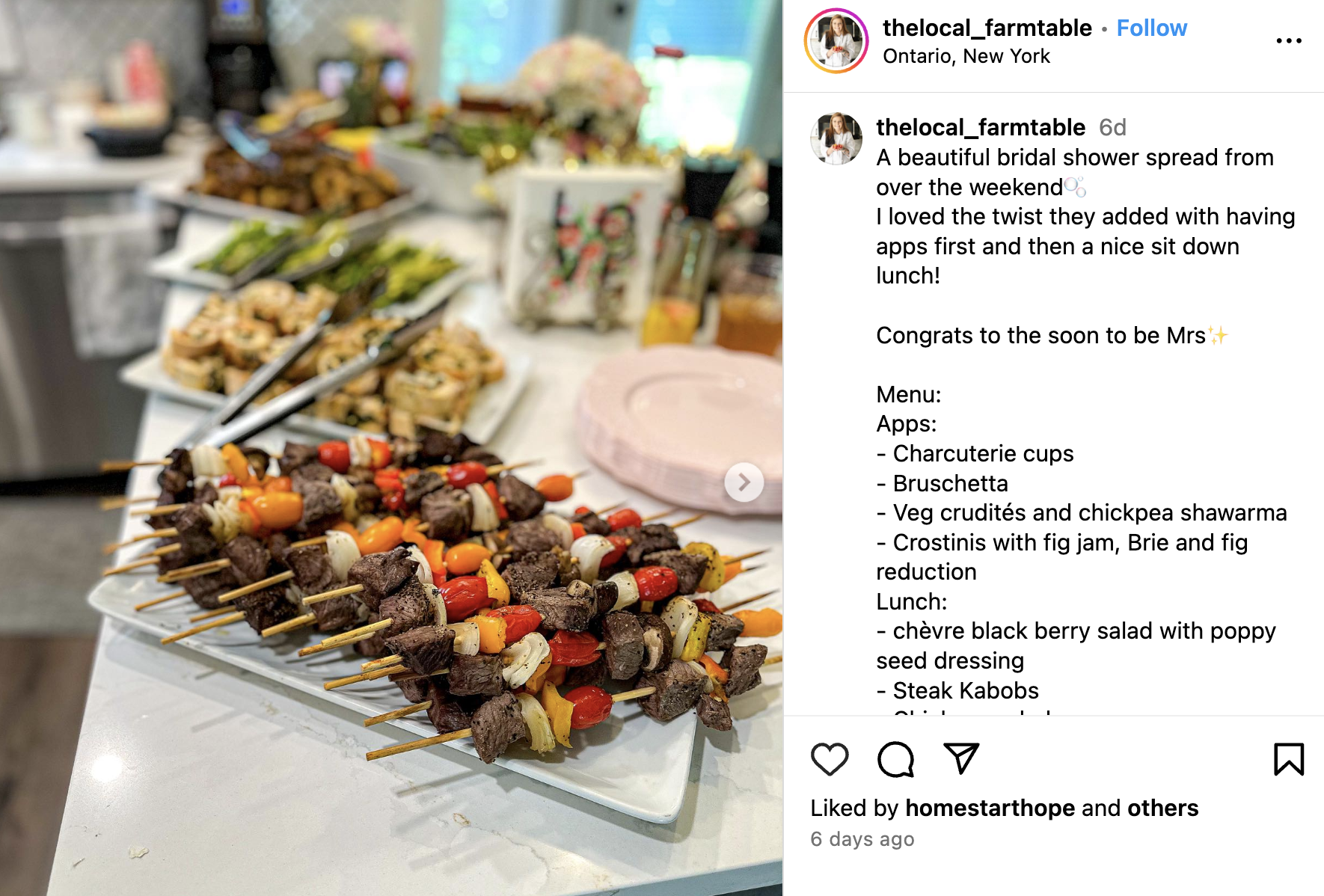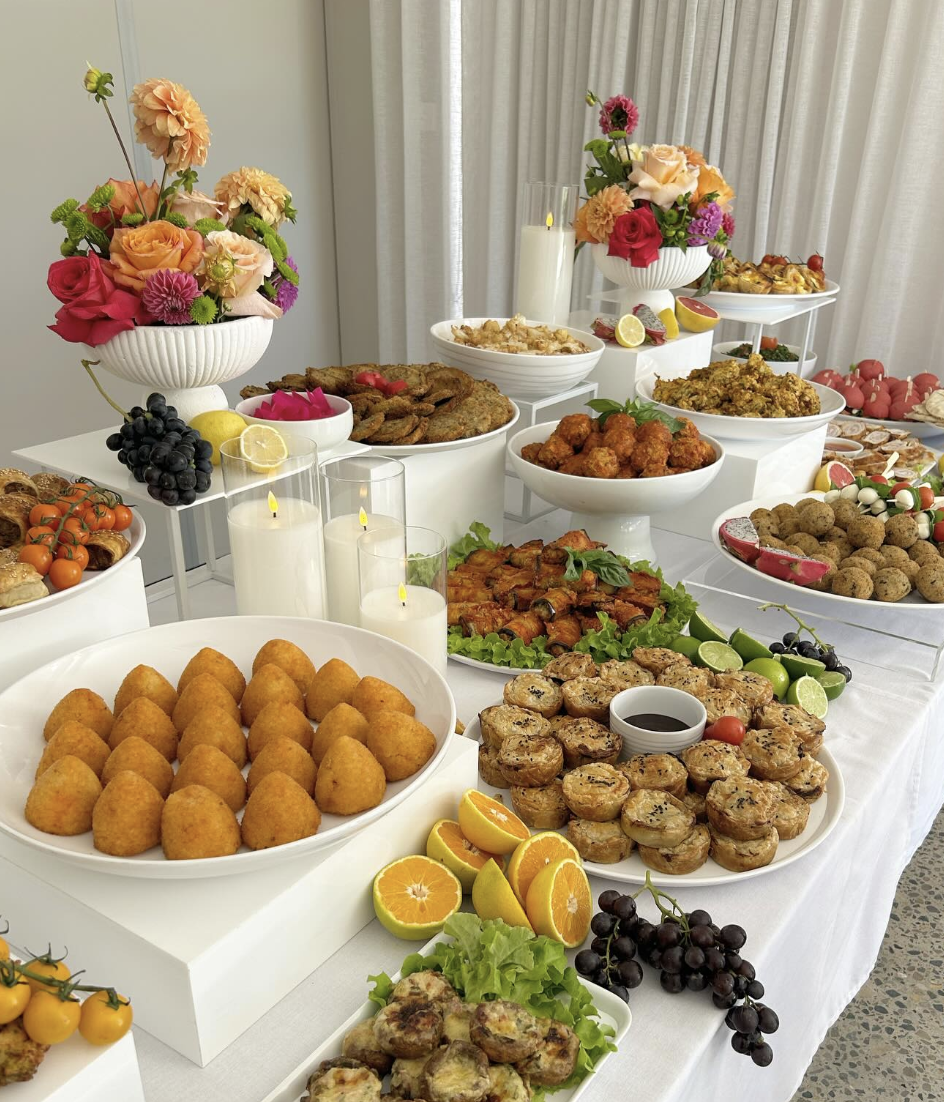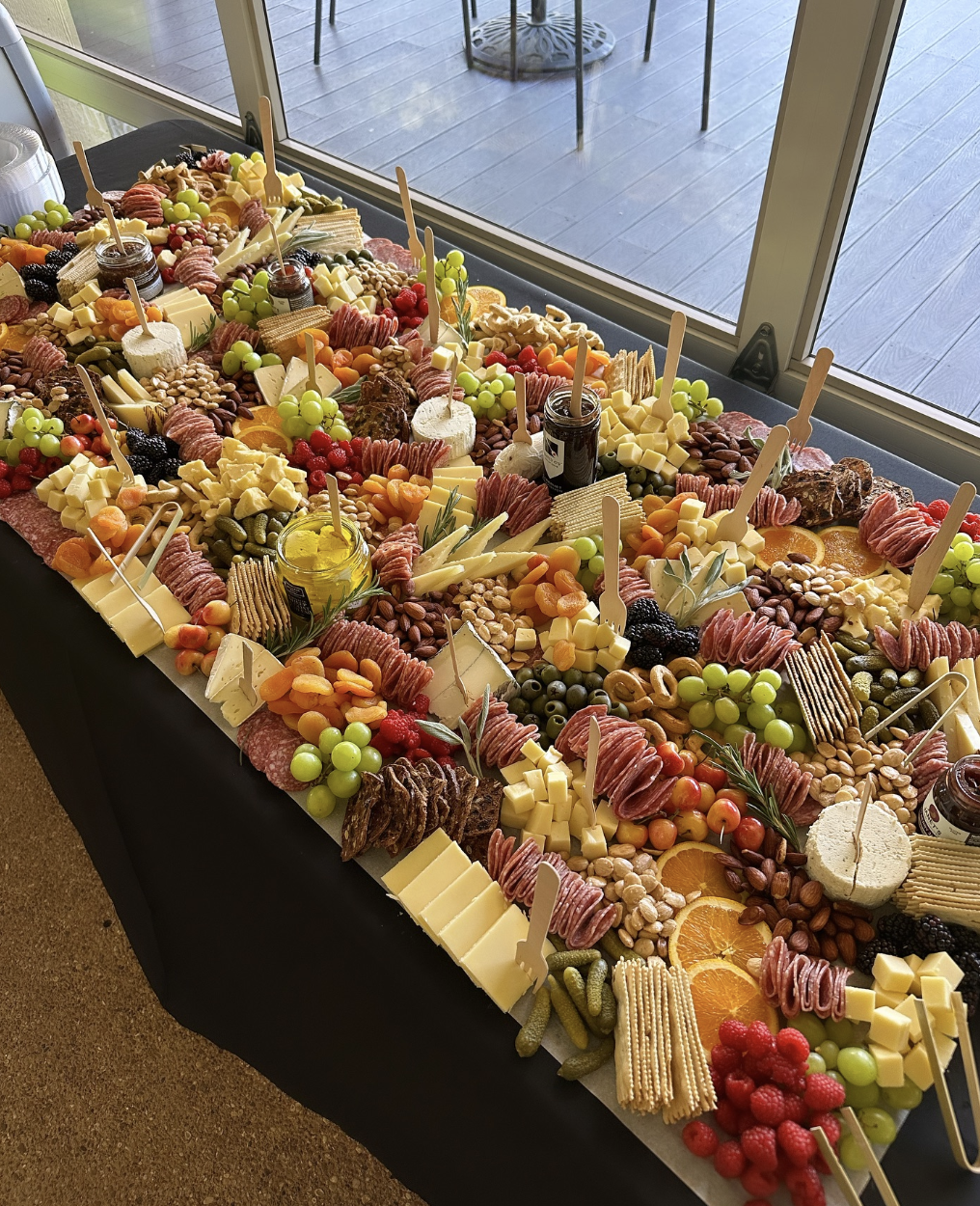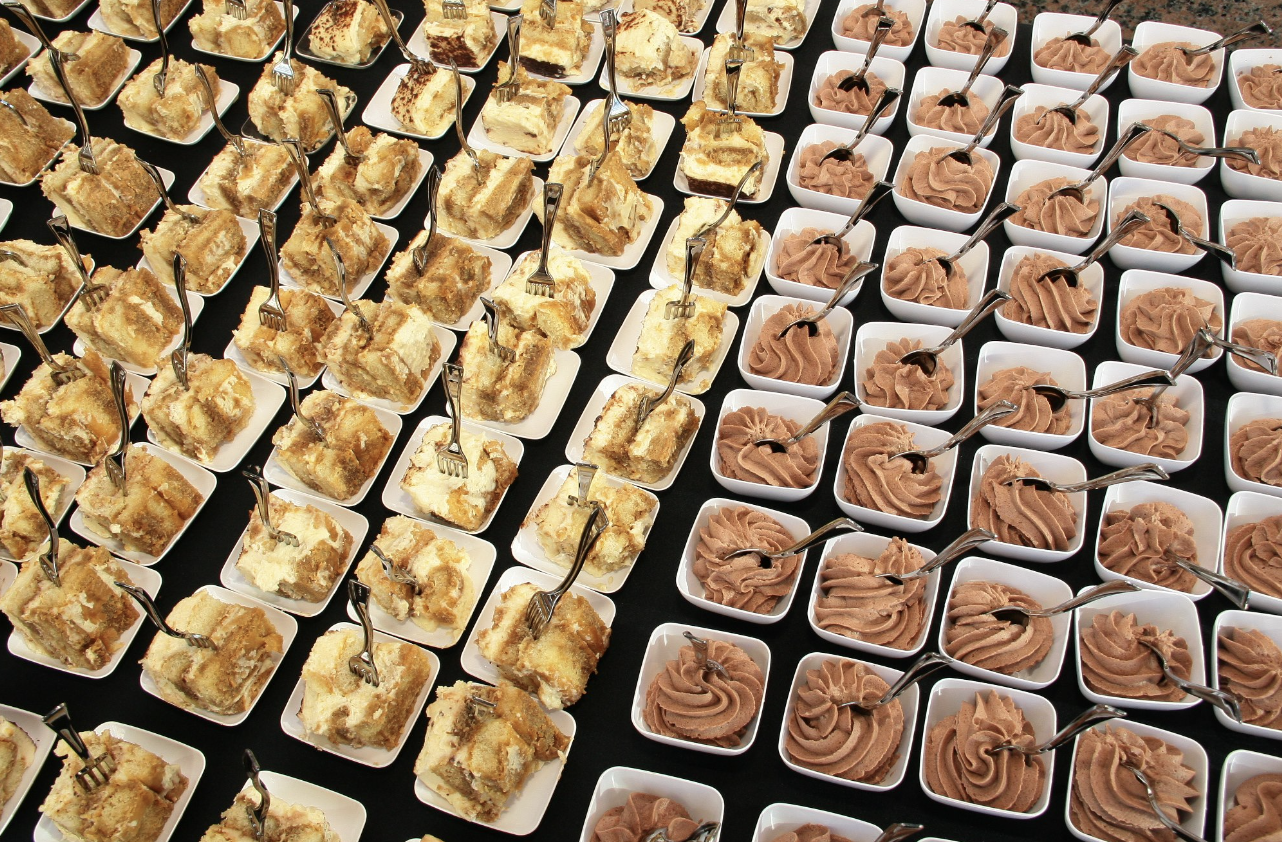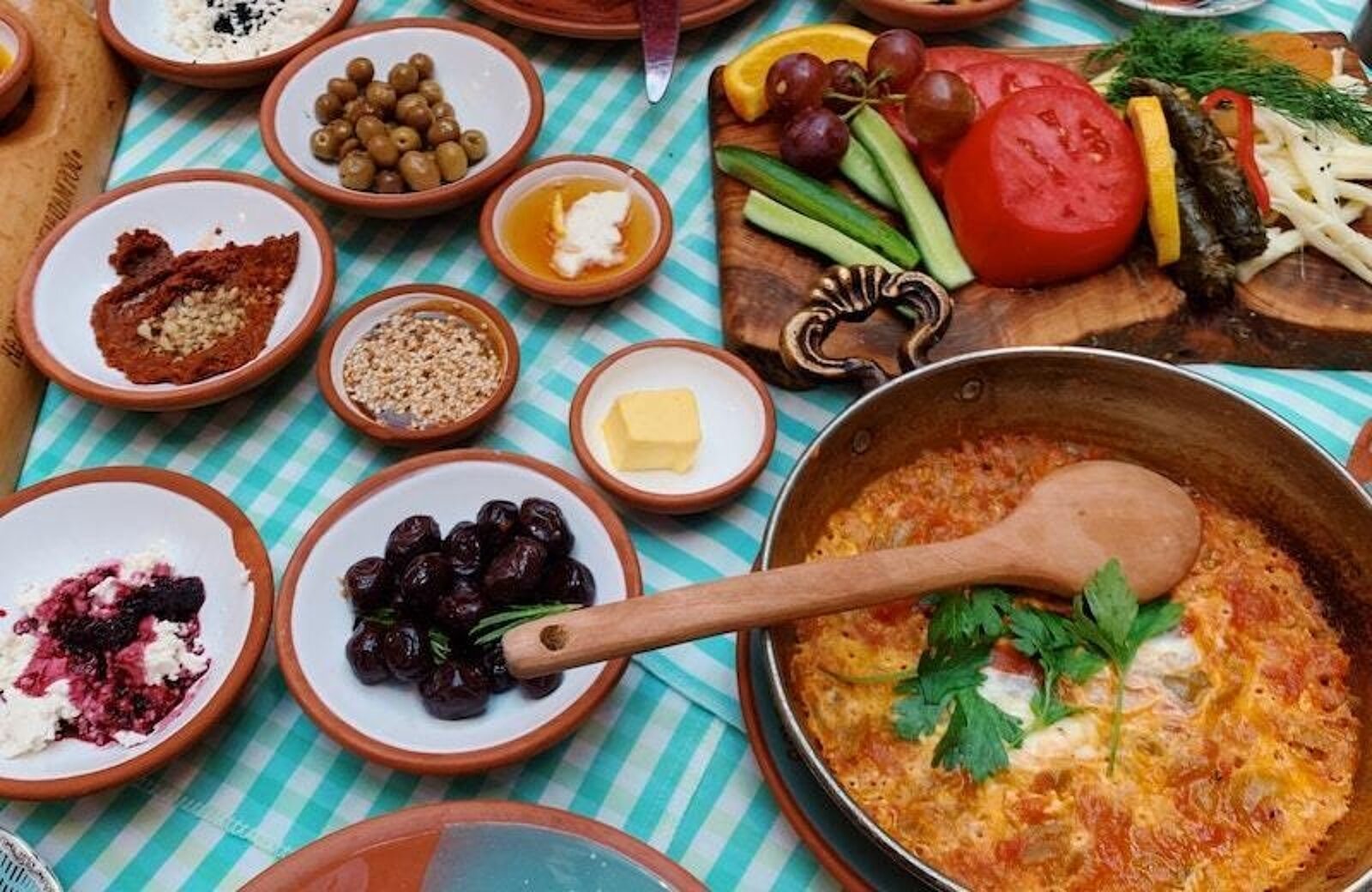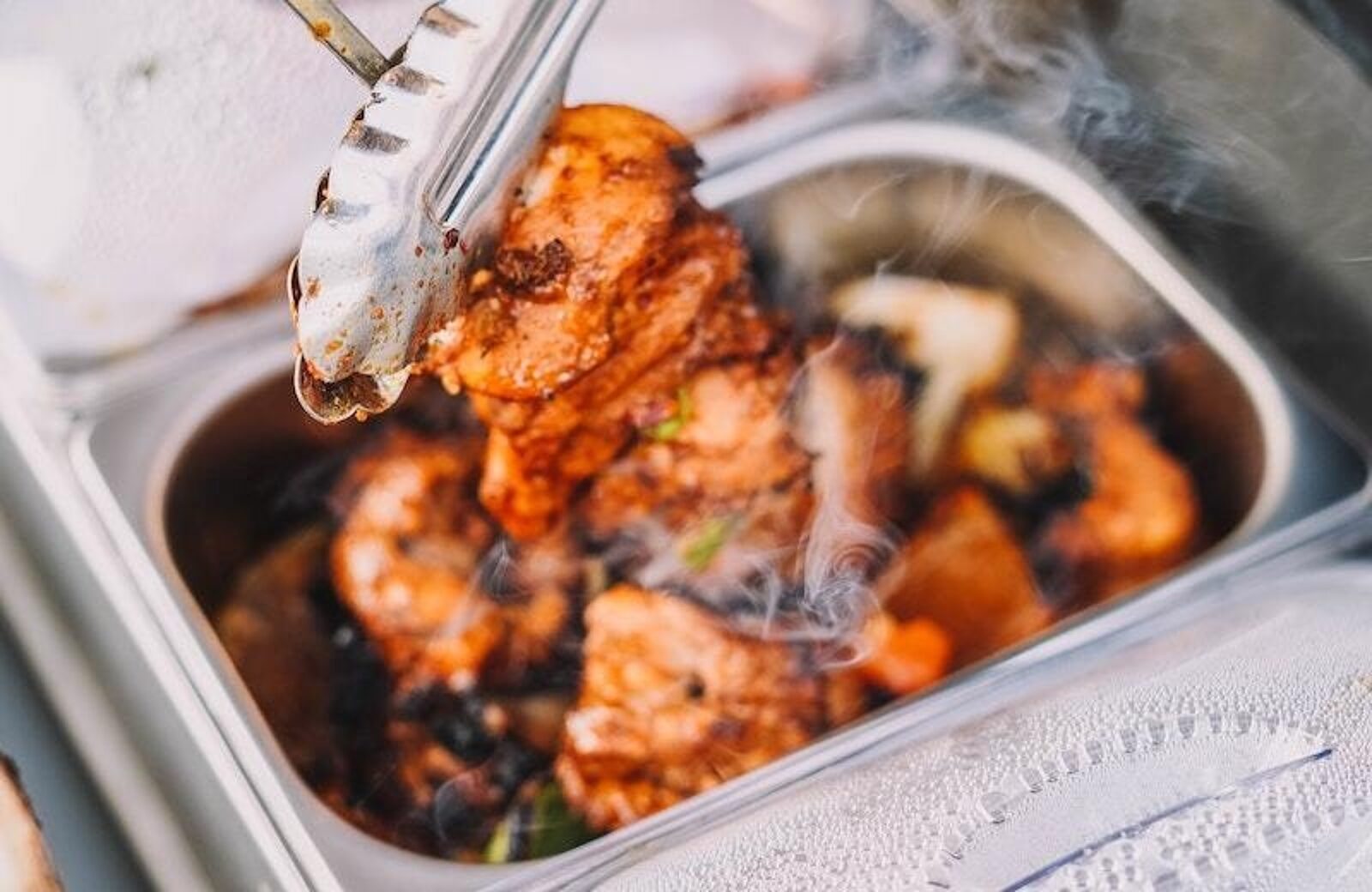
Catering Recipes: How to Develop Catering Recipes [2024]
In this article, we’ll explain how you can start crafting unique dishes for your catering business, giving you the best chance of standing out from the competition.
Aidan ToborAuthor
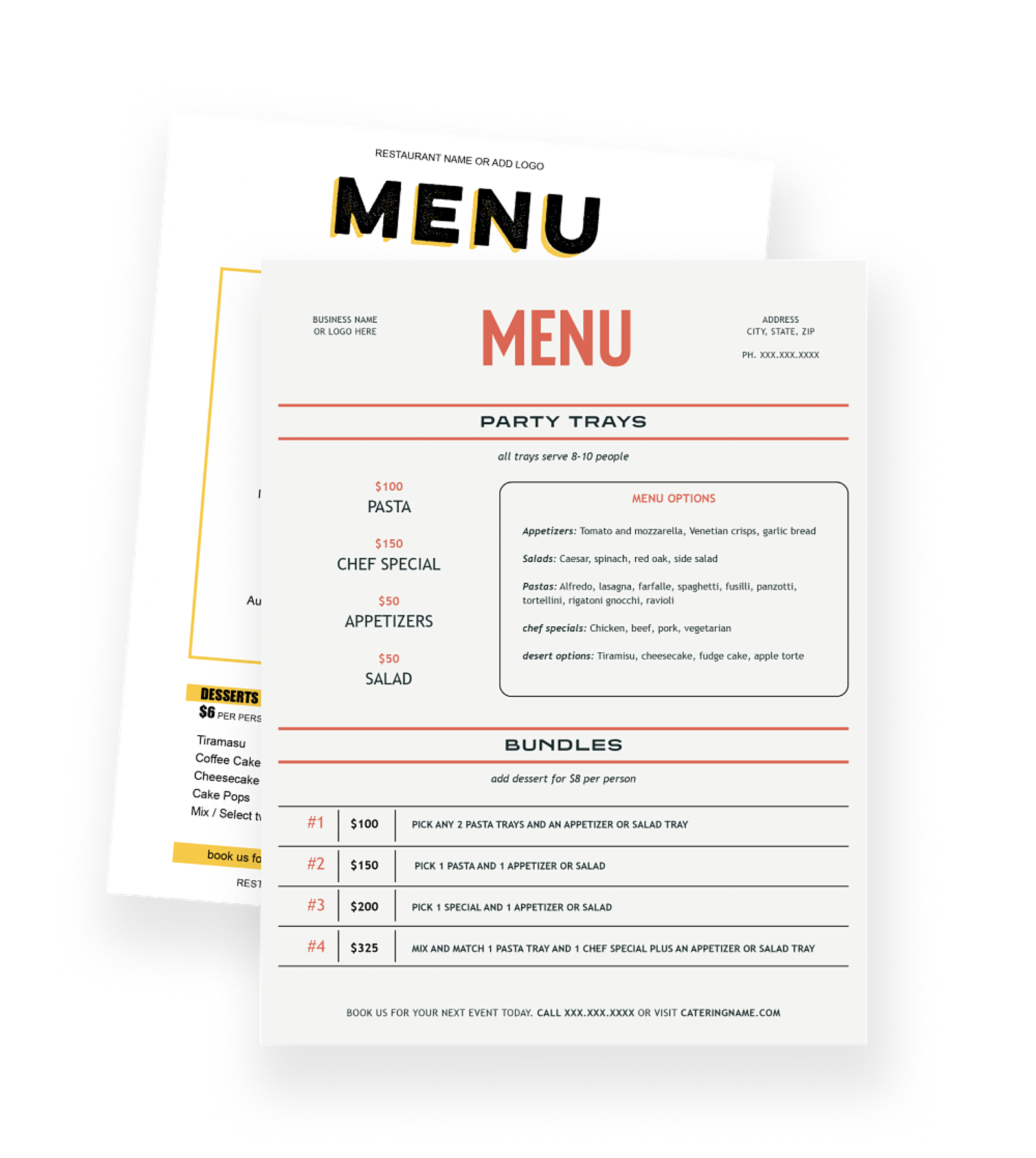

Catering Menu Templates
Use these catering menu templates as a starting point for your menu design or to give your menu a refresh.
Get free downloadAlthough the Covid-19 pandemic had a negative impact on catering businesses, the industry still generates an impressive $12.2 billion per year. While you’ll need to carefully craft the right concept, there’s still plenty of opportunity in this industry.
After all, according to Restaurant Business Online, 78% of consumers report that the taste and quality of food is the most important factor influencing their choice of caterer. So, as long as you can develop and perfect delicious catering recipes, there’s a good chance you’ll be successful!
That’s why, in this article, we’ll explain how you can start crafting unique dishes for your catering business, giving you the best chance of standing out from the competition.
Key takeaways
Before you begin developing your catering recipes, it’s crucial to define your business concept. This includes the types of events you plan to cater, your style of cuisine, and other unique selling points.
As you brainstorm catering recipes, look for inspiration from local food markets, other catering businesses, food influencers, culinary events, and current dining trends.
To create your own unique recipes, start with basic versions of each dish and then experiment with different flavors, textures, and presentations. Most importantly, feel free to get creative!
Test and retest your recipes to learn what you can improve so you can perfect each dish.
Consider sourcing local ingredients, and be sure to implement standardized procedures to ensure consistency as you scale up your recipes.
Let's dive in.
Catering Menu Templates
Use these catering menu templates as a starting point for your menu design or to give your menu a refresh.

1. Define your catering business concept
Before you start developing your catering recipes, it’s crucial to define your concept. After all, your concept will guide every aspect of the recipe development process, from ingredient selection to presentation.
To get a clearer understanding of your concept, be sure to consider the following advice.
Identify your target market and niche
Understanding who your ideal customers are and identifying a niche will help you tailor your recipes to meet specific needs.
To get a feel for who your target customers are, think about the types of events you want to cater, such as:
Weddings
Corporate events
Casual gatherings, like birthday parties
Additionally, you may want to consider offering niche catering services to set your business apart from competitors. For example, you could offer:
Gourmet vegan dishes
Regional cuisine, like Mediterranean, Indian, or Mexican
Farm-to-table, locally-sourced menus
A specific food specialty, like ice cream or crepes
Overall, it’s important to think about what will make your catering service unique. This could be a signature dish, a specific presentation style, or a particular culinary influence.
Of course, some catering businesses, like sustainability-focused LUX, take their unique selling point to the next level, focusing on more than just food. In an interview with the US Chamber of Commerce, Sarah McClure, the company’s Director of Marketing, said:
“There are so many simple ways to produce a green event, such as sustainable rentals and linen options, coordination of mass transit, offering guests public transportation, menus featuring local ingredients — which helps to boost community revenue and reduce our carbon footprint — paperless proposals and invitations, eco-friendly centerpiece options, and so much more.”
So remember, the market and niche you select will not only shape the style, flavor, and presentation of all of your recipes, but the values and entire foundation of your business.
Analyze your competition
Not only is market research important for defining your target customers, but it’s also key for understanding the competitive landscape.
It’s vital to pay attention to what kinds of services other local caterers are providing by looking at their:
Menus
Pricing
Branding
Overall, identifying gaps in the market that you can fill with your unique recipes and services is crucial for building a catering concept that stands out.
Assess your capabilities
Your catering concept should also take into account the level of service you can realistically provide. This depends on several key factors, including:
Kitchen capabilities/cooking equipment
Staff expertise
Available resources
Ultimately, these factors will determine the complexity and volume of recipes your business is able to handle.
For example, if you have a small team, you may want to focus on high-quality, smaller-scale events rather than large, elaborate banquets.
2. Research catering recipe ideas
Once you have your catering concept nailed down, you’re ready to start finding potential recipes.
So, think about the following strategies as you research dishes that fit with your idea.
Explore trends and popular cuisines
Staying ahead of the curve with food trends is essential for any catering business. To discover popular cuisines that customers will love, consider doing a deep dive into:
Culinary publications
Food trend reports
Global food culture websites
This can help you understand emerging trends like plant-based and vegan diets, ethnic street foods, and regional specialties.
Additionally, try analyzing the popularity of these trends and consider how you can adapt them to fit your catering menu.
Visit local food markets and catering businesses
Local food markets are treasure troves of inspiration, offering a plethora of fresh, seasonal ingredients.
So, think about spending time observing and interacting with vendors to learn about unique products and their culinary uses.
Likewise, visiting established catering businesses can provide insights into successful menu items and operational practices.
Just be sure to take note of presentation styles, ingredient combinations, and customer reactions.
Restaurant Banquet Event Order (BEO) Template
This free BEO template can help your restaurant optimize incoming catering requests and streamline documentation.

Follow food influencers
Food blogs, social media influencers, and cooking shows are great sources of inspiration and innovation.
You can find awesome recipe ideas by subscribing to popular food blogs and following influential chefs and food enthusiasts on social media platforms. These influencers often showcase inventive recipes and cooking techniques, along with valuable tips on presentation and flavor combinations.
Additionally, cooking shows, especially those that focus on professional chefs, can provide a behind-the-scenes look at how to craft exceptional dishes.
Attend culinary events
Lastly, food festivals and culinary events are excellent opportunities to immerse yourself in diverse culinary experiences.
These events often feature renowned chefs, emerging culinary talents, and innovative food concepts. So, to spark new ideas and get inspiration for unique twists on classic recipes, consider:
Participating in workshops
Attending tasting sessions
Networking with fellow food professionals
Ultimately, the more you immerse yourself in these different types of culinary experiences, the more chances you’ll have to discover inspiration for your own catering recipes.
3. Brainstorm initial catering recipe ideas
Now that you have a concept and have done some research into potential recipes, it’s time to start brainstorming some dish ideas that may work well for your business.
As you think about which recipes you want to integrate into your catering business, be sure to implement the following advice.
List potential dishes
Start by listing a wide range of potential dishes that align with your chosen cuisine and business concept.
To accomplish this, feel free to get creative! It’s generally a good idea to include a mix of traditional favorites and innovative new ideas.
Additionally, ensure your list should cover various meal components, from appetizers and main courses to sides, desserts, and beverages.
You may even want to start a spreadsheet where you can organize all of your initial ideas. Be sure to note important aspects of each recipe, such as:
Main ingredients
Level of complexity
Preparation time
Type of recipe (ie, appetizer, main course, side, etc.)
Overall, a well-organized shortlist of recipes will make it easier for you to narrow down the best options once you’ve finished the brainstorming process.
Consider seasonal ingredients and local produce
Incorporating seasonal ingredients and local produce not only enhances the flavor and freshness of your dishes, but also supports local farmers and reduces costs.
However, if you decide to buy local, it’s key to research seasonal produce calendars and build your menu around ingredients that are in-season.
This approach can also lead to new and exciting menu items that change with the seasons.
Think about menu diversity
A well-rounded menu offers a diverse range of options to cater to different tastes and dietary needs. So, it’s important to ensure your menu includes a variety of proteins, vegetables, grains, and desserts.
Additionally, consider balancing familiar comfort foods with adventurous dishes to appeal to a broad audience.
Lastly, you might think about offering customizable options, allowing clients to mix and match components to suit their preferences.
4. Develop unique catering recipes
At this point, you should have a robust list of potential recipes that align with your concept that you use for your catering business.
So, now you’re ready to take these ideas and put your own spin on them to help you stand out from the competition.
Start with basic versions of each dish
The first step to coming up with your own recipes is to develop basic versions of each dish on your menu.
These initial versions should capture the essence of the dish and serve as a foundation for further refinement.
By focusing on mastering fundamental techniques and achieving a balanced flavor profile, you’ll have an easier time putting your own spin on each recipe
Experiment with different ingredients and cooking techniques
Experimentation is key to creating standout recipes. So, be sure to try out different ingredients, spices, and cooking methods. This can help you enhance the flavor, texture, and visual appeal of your dishes.
Additionally, it’s a good idea to document each variation and its results, noting what works well and what needs improvement.
Remember, thinking outside the box can help you push culinary boundaries, allowing your business to differentiate itself.
Focus on balancing flavors, textures, and presentations
A successful dish balances flavors, textures, and presentation. Therefore, it’s important to ensure that each component of your dish complements the others. This helps create a harmonious and satisfying experience.
Additionally, be sure to pay attention to the visual appeal of your dishes. After all, presentation plays a significant role in customer perception and satisfaction.
Opening a Catering Business Checklist
So many things go into opening a catering business. With this free PDF checklist, you'll set your new business up for success.

Keep portion sizes and pricing in mind
Lastly, it's crucial to consider portion sizes and pricing to ensure your dishes are cost-effective and provide value to your customers.
So, be sure to calculate the cost of ingredients and determine an appropriate price point that covers expenses and generates a profit.
Keep in mind the expectations of your target market regarding portion sizes and pricing. As a catering business, you’ll likely need to produce quite a bit of food for each client, meaning the cost of scaling up your recipes is a key consideration.
5. Test and refine your catering recipes
Now that you’ve developed some new and exciting catering recipes, it’s time to see what people think!
By testing and refining your dishes, you’ll ensure each guest has a great experience when you start serving them at events.
Conduct taste tests
Organize taste tests with a diverse group of people, including friends, family, and potential customers.
As they test out your recipes, be sure to gather honest feedback on various aspects of each dish, including:
Flavor
Texture
Presentation
Overall appeal
Ultimately, this feedback will provide valuable insights into how clients will perceive your recipes and where you can make improvements.
Gather feedback
The best way to gather and organize feedback is to use structured feedback forms to collect detailed opinions on each dish.
For example, you should ask testers to rate aspects such as flavor balance, texture, presentation, and overall satisfaction.
From there, you can analyze this feedback to identify common themes and areas you may want to adjust.
Make tweaks based on feedback and retest
Based on your testers’ feedback, the next step is to make adjustments to your recipes. This may involve:
Tweaking ingredient quantities
Modifying cooking techniques
Rethinking presentation styles
Once you make these adjustments, you should then retest the revised recipes to ensure the changes have enhanced the dish without compromising its core qualities.
Ensure consistency
Consistency is crucial in the catering business, so be sure to develop standardized recipes and procedures. This will help ensure that every batch of your dishes maintains the same taste, quality, and presentation.
This consistency will build trust and reliability with your customers, helping you build long-term sustainability for your catering business.
6. Source your ingredients
After testing and retesting your catering recipes, you should have some of them perfected and ready to serve to the world.
Before you can start scaling, however, you first need to source your ingredients. So, use the following advice as you consider how to secure the right ingredients.
Find reliable suppliers
Building relationships with reliable suppliers is essential for maintaining the quality of your ingredients.
Therefore, it’s key that you research and vet potential suppliers, looking for those who offer fresh, high-quality products consistently.
Additionally, be sure to consider factors such as:
Delivery schedules
Pricing
The supplier's reputation in the industry
Remember, reliable suppliers are vital to creating consistent and high-quality food for your clients.
Build relationships with local farmers and markets
Establishing connections with local farmers and markets can provide access to fresh, seasonal produce and unique ingredients.
These relationships can also foster community support and sustainability, which can appeal to potential clients looking to support their local communities.
To find nearby suppliers for your ingredients, think about attending farmers' markets and local food events to network with producers and explore potential partnerships.
Consider cost-effective options
While managing costs is important, you should never compromise on the quality of your ingredients. After all, providing consistently high-quality food is vital for establishing a good reputation in the industry and securing new clients.
To keep your expenses lower, however, think about exploring cost-effective options, such as bulk purchasing or negotiating discounts with suppliers.
Overall, it’s key to strike a balance between cost and quality that aligns with your business goals.
Plan for ingredient availability
Planning your menu around the availability and seasonality of ingredients is another important consideration, especially if you’re using local suppliers.
So, think about creating a flexible menu that you can adjust based on seasonal changes and ingredient availability. This will allow you to take advantage of peak flavors, fresh ingredients, and cost savings.
Ultimately, this approach ensures that you can consistently deliver fresh, flavorful dishes.
7. Scale your catering recipes
Now it’s time for the last step in putting your recipes together–scaling up your dishes so you can serve large groups!
As you think about the best ways to make big batches of your dishes, be sure to keep the following tips in mind.
Adjust recipes for larger batches
Scaling recipes for larger batches requires careful adjustment to maintain flavor and consistency.
So, it’s crucial to use precise measurements and ratios to ensure that each component is properly proportioned.
Additionally, you should make sure you test the scaled-up recipes to confirm that the taste and quality remain intact.
Ensure consistency for each serving
Consistency in taste and presentation is critical, especially when serving large groups.
Therefore, it’s vital that you develop standardized procedures and train your team to follow them carefully.
For example, be sure to use portion control tools, such as measuring spoons and scales, to ensure uniformity across all servings.
Consider storage and space limitations
Lastly, you’ll need to ensure you take into account the storage and space limitations of your catering setup.
To accomplish this, be sure to plan your menu and prep processes to optimize space and ensure that ingredients and prepared dishes are stored safely and efficiently.
To make the most of your limited space, consider using:
Stackable containers
Compact equipment
Strategic layout planning
Start creating the perfect catering recipes
Developing recipes for a catering business involves a blend of research, creativity, and careful planning.
By following the steps outlined above, you can create unique and appealing dishes that stand out from the competition.
Remember, creativity, persistence, and striving for excellence are the key to taking your catering business from concept to execution.
Of course, it’s also essential that you use the right tools to streamline your operations and improve your clients’ experiences.
Fortunately, with Toast you can streamline your event planning, automate essential tasks, stay organized, and much more. To learn all the ways you can take your catering business to the next level, be sure to check out all of Toast’s catering and events features!
Catering Opening & Closing Checklist
The beginning and end of a shift can be frantic. Use this free PDF checklist to set your catering staff up for success.

Related Resources
Is this article helpful?
DISCLAIMER: This information is provided for general informational purposes only, and publication does not constitute an endorsement. Toast does not warrant the accuracy or completeness of any information, text, graphics, links, or other items contained within this content. Toast does not guarantee you will achieve any specific results if you follow any advice herein. It may be advisable for you to consult with a professional such as a lawyer, accountant, or business advisor for advice specific to your situation.
Read More
Subscribe to On the Line
Sign up to get industry intel, advice, tools, and honest takes from real people tackling their restaurants’ greatest challenges.


